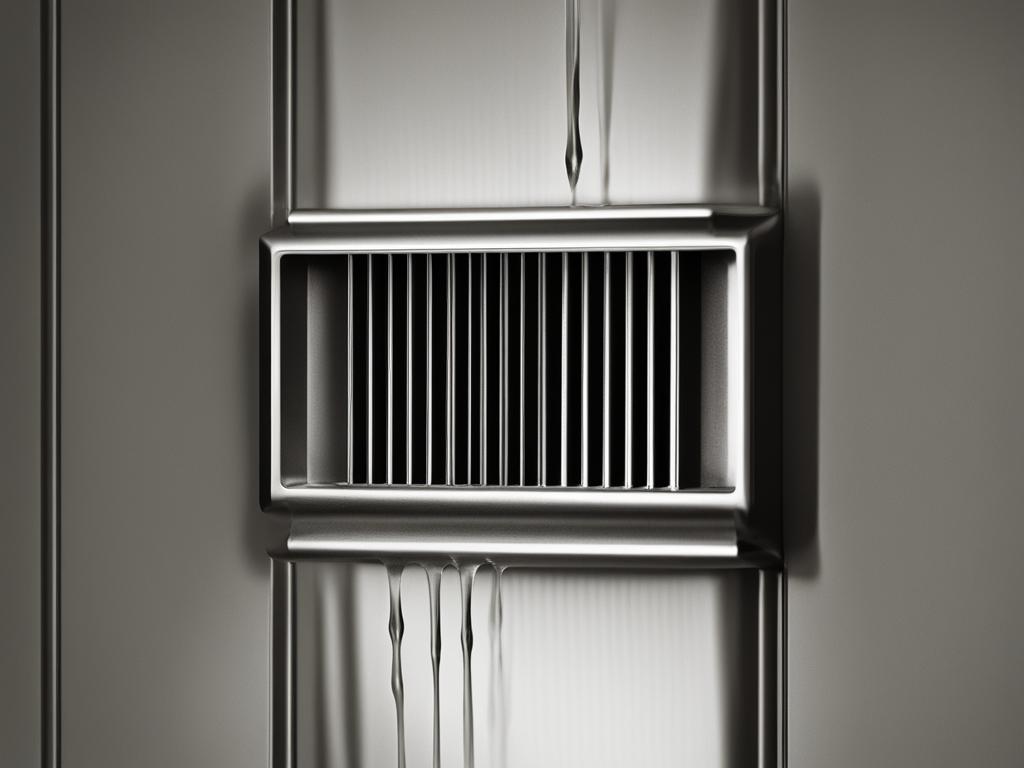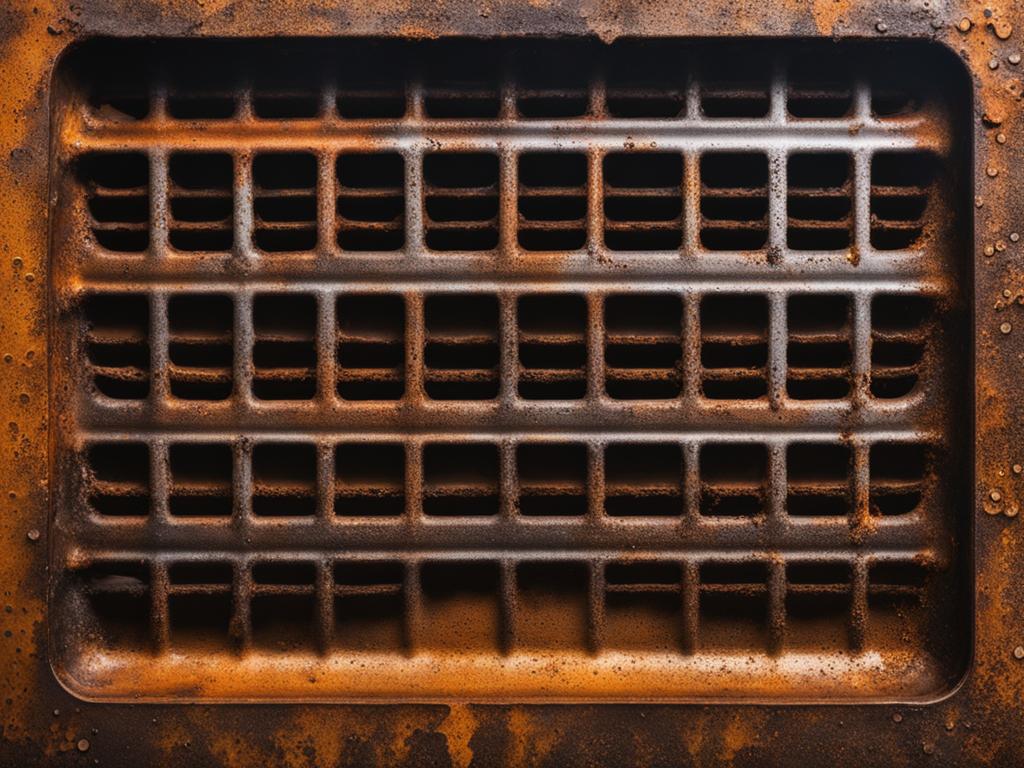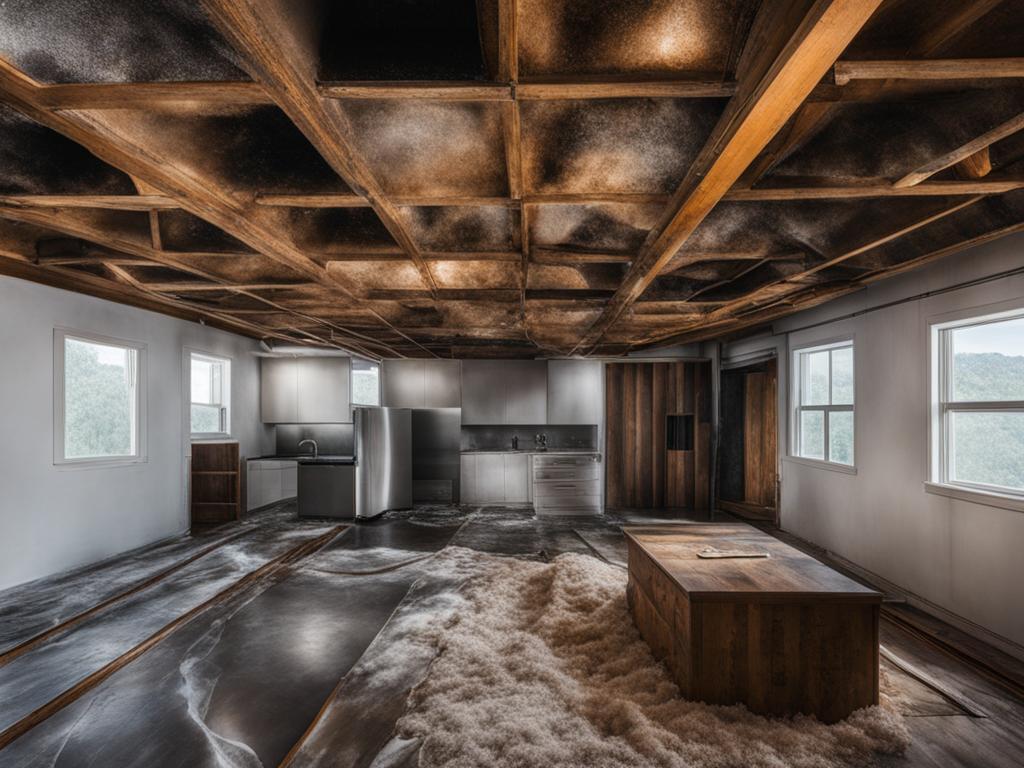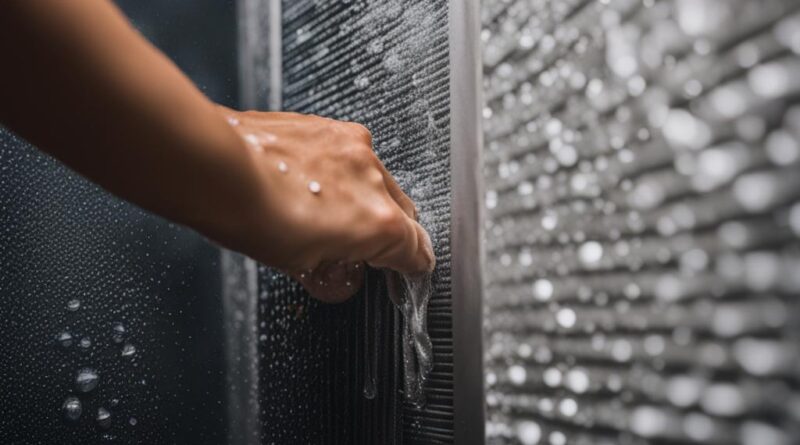Your Guide on How to Stop Water Dripping from AC Vent
Water dripping from an AC vent can be a common problem that homeowners face. It is important to identify the cause of the water leakage and take appropriate measures to address it. This comprehensive guide will provide you with practical solutions to stop water dripping from your AC vent.
Key Takeaways:
- Identify the common causes of water dripping from AC vents
- Troubleshoot plumbing or roof leaks as a possible cause
- Address poor HVAC installation issues
- Seal air leaks around the vent
- Replace dirty air filters
Common Causes of Water Dripping from AC Vent
Understanding the common causes of water dripping from an AC vent is essential in finding the right solution to prevent water leakage. By identifying these issues, you can address them promptly and ensure the efficient operation of your AC system.
Rusted Drip Pan
One of the common culprits behind water dripping from an AC vent is a rusted drip pan. Over time, the drip pan can corrode, leading to water leakage. To address this issue, it is necessary to remove the access panel of the AC unit and inspect the condition of the drip pan. If rusted, replacing it with a new one is recommended. Ensure proper installation to prevent further water leakage.
Clogged Condensate Drain Line
A clogged condensate drain line can also contribute to water dripping from the AC vent. Over time, dirt, debris, and algae can accumulate in the drain line, obstructing the flow of condensate. This blockage can cause water to back up and leak from the vent. To resolve this issue, the condensate drain line should be cleaned using a mixture of vinegar and water or a specialized cleaning solution. Regular maintenance can help prevent future clogs and water leakage.
| Common Causes | Solutions |
|---|---|
| Rusted Drip Pan | Replace with a new drip pan |
| Clogged Condensate Drain Line | Clean the drain line regularly |
These are just a couple of the common causes of water dripping from an AC vent. Other issues such as air leaks, dirty air filters, and refrigerant leaks can also contribute to water leakage. By identifying the underlying cause, you can take the necessary steps to address the problem effectively and prevent further damage to your AC system.
Air Leaks
Air leaks around the AC vent can result in condensation buildup and water leakage. To determine if this is the cause, feel for any air coming out from the sides of the vent. If air is escaping, using caulk to seal the leaks can prevent further water leakage. Additionally, ensuring proper insulation around the air ducts can help maintain optimal temperature and prevent condensation.
Dirty Air Filters
Dirty air filters can disrupt the airflow in the AC system, leading to water freezing over the evaporator coils. When the AC is turned off, the ice melts and drips from the vent. Regularly replacing the air filters can help prevent this issue and maintain the efficiency of your AC system.
Plumbing or Roof Leak
A plumbing or roof leak can be one of the causes of water dripping from an AC vent. It is important to check for any signs of leaks in your plumbing system or roof that could be entering the AC system and causing water to drip from the vent. If you notice water stains or dampness on the ceiling or walls near the AC vent, it could be an indication of a leak.
To troubleshoot this issue, inspect your plumbing system for any visible leaks, such as dripping faucets or water stains around pipes. If you suspect a roof leak, look for missing or damaged shingles, cracked flashing, or signs of water infiltration in the attic. It is recommended to contact a professional plumber or roofer to properly assess and repair any leaks.
Addressing the plumbing or roof leak promptly is essential to prevent further water damage and potential mold growth. Once the leak is fixed, monitor the AC vent for any signs of continued water dripping. If the issue persists, further investigation may be needed to identify any additional causes or underlying problems.
| Cause | Symptoms | Recommended Action |
|---|---|---|
| Plumbing leak | Water stains or dampness near the AC vent | Contact a professional plumber to fix the leak |
| Roof leak | Missing or damaged shingles, cracked flashing, signs of water infiltration in the attic | Consult a professional roofer to repair the roof |
By addressing plumbing or roof leaks, you can eliminate one of the potential causes of water dripping from your AC vent. However, if the issue persists or you suspect other causes, continue reading the next sections for more troubleshooting tips and solutions.
Poor HVAC Installation
Improper installation of an HVAC system can be a leading cause of water leakage from AC vents. When the unit is not correctly installed, it can result in issues with the drain pan, leading to leaking AC vents. It is crucial to ensure that the unit and the drain pan are properly positioned and installed to prevent water dripping. If you have recently had a new AC system installed and are experiencing water leakage, it is recommended to contact the installer or an HVAC professional to rectify the installation issue.
In some cases, the unit or drain pan may be tilted, causing condensation to collect and drip from the vent. This can occur if the unit was not level during installation or if it has shifted over time. It is important to address this issue as soon as possible to prevent further water damage and to ensure the efficient operation of your AC system. A professional can assess the installation and make any necessary adjustments to correct the problem.
Proper installation of an HVAC system is essential for its optimal performance and to prevent water leakage from AC vents. If you suspect that poor installation is the cause of the water dripping, it is recommended to seek professional assistance rather than attempting to fix the issue yourself. A trained HVAC technician will have the knowledge and expertise to identify and rectify any installation problems, ensuring that your AC system operates effectively and efficiently.
Air Leak Around the Vent
An air leak around the AC vent can contribute to condensation buildup, which can lead to water dripping from the vent. To determine if an air leak is the cause of the problem, you can perform a simple inspection. Place your hand near the sides of the vent and feel for any air escaping. If you detect air leakages, it’s important to seal them properly to prevent further water leakage.
To seal the air leaks around the vent, you can use caulk. Apply the caulk around the edges of the vent, ensuring a tight seal. This will help to keep the conditioned air inside the room and prevent excess moisture from entering the vent. By sealing the air leaks, you can effectively reduce condensation buildup and eliminate water dripping from the AC vent.
Note: It’s essential to ensure that the caulk is properly applied and dried before turning on the AC system again. This will allow the caulk to form a strong seal and prevent any potential air leaks.
If you’re unsure about how to seal the air leaks or if the problem persists after sealing, it’s advisable to seek assistance from a professional HVAC technician. They can accurately diagnose the issue and provide appropriate solutions to address the air leaks around the AC vent.
Preventing air leaks around the vent is crucial not only for stopping water dripping but also for improving the overall efficiency of your AC system. By maintaining a tight seal, you can ensure that the conditioned air is properly distributed throughout the room without any wastage. This can help lower energy consumption and reduce utility costs.

Summary:
- Air leaks around the AC vent can cause condensation buildup and water dripping.
- Inspect the vent for air leakage by feeling for escaping air around the edges.
- Seal the air leaks with caulk to prevent further water leakage.
- Consult a professional HVAC technician if you’re unsure or if the issue persists after sealing.
- Properly sealing the air leaks improves AC efficiency and reduces energy consumption.
Dirty Air Filters: A Common Cause of Water Dripping from AC Vents
One of the common causes of water dripping from AC vents is dirty air filters. When the air filters become clogged with dust, dirt, and debris, it restricts the airflow through the system. As a result, the evaporator coils can get too cold and freeze over.
When the AC unit is turned off, the ice on the coils melts, causing water to drip from the vents. This can not only lead to water damage but also impact the overall performance and efficiency of the HVAC system.
To troubleshoot this issue, it is important to regularly clean or replace the air filters. Depending on the type of filter, this should be done every 1-3 months or as recommended by the manufacturer. By maintaining clean air filters, you can ensure proper airflow, prevent condensation, and minimize the risk of water dripping from the AC vents.
Impact of Dirty Air Filters on AC Operation
Dirty air filters not only contribute to water dripping from AC vents but also affect the overall operation of the system. When the filters are clogged, the airflow is restricted, causing the AC unit to work harder to cool the space. This means it consumes more energy and puts unnecessary strain on the system, potentially leading to increased wear and tear as well as higher energy bills.
In addition, dirty air filters can result in poor indoor air quality as they fail to effectively trap dust, allergens, and other pollutants. This can lead to respiratory issues and discomfort for the occupants of the space. Regularly cleaning or replacing the air filters is crucial for maintaining optimal AC operation, improving energy efficiency, and ensuring clean, healthy air.
“Regularly clean or replace your air filters to prevent water dripping from AC vents and to maintain optimal AC operation and indoor air quality.” – HVAC Professional
| Benefits of Clean Air Filters | Consequences of Dirty Air Filters |
|---|---|
|
|
Rusted Drip Pan
A rusted drip pan can be a common cause of water leakage from an AC vent. The drip pan, also known as the condensate pan, collects the condensation produced by the AC system. Over time, the drip pan may develop rust due to exposure to moisture and constant contact with water. This rust can lead to cracks or holes in the pan, allowing water to escape and drip from the AC vent.
To address this issue, it is essential to inspect the condition of the drip pan. Start by removing the access panel of the AC unit. Carefully examine the drip pan for any signs of rust or damage. If you notice rusted areas or visible holes, it is necessary to replace the drip pan with a new one.
If you are confident in your DIY skills, you can attempt to replace the drip pan yourself. However, if you are unsure or uncomfortable with the process, it is recommended to seek the assistance of an HVAC professional. They will have the expertise and tools needed to remove the old drip pan and install a new one correctly.
| Steps for Replacing a Rusted Drip Pan: |
|---|
| 1. Turn off the power: Before starting any work, make sure to turn off the power supply to the AC unit to avoid any electrical hazards. |
| 2. Remove the access panel: Locate the access panel of the AC unit and carefully remove it. |
| 3. Disconnect the drain line: Locate the drain line connected to the drip pan and disconnect it. Use a towel or bucket to collect any water that may come out. |
| 4. Remove the old drip pan: Unscrew or unclip the old drip pan from its position. Take note of how it was installed as a reference for the new drip pan. |
| 5. Install the new drip pan: Position the new drip pan properly and secure it in place using screws or clips. Reconnect the drain line. |
| 6. Test for leaks: After installing the new drip pan, turn on the AC unit and check for any signs of leaks. If everything appears to be in order, replace the access panel. |
By replacing a rusted drip pan, you can prevent water leakage from the AC vent and ensure the proper functioning of your HVAC system.

Uninsulated Air Ducts
One of the common causes of water dripping from an AC vent is uninsulated air ducts. When air ducts run through areas that lack insulation, such as the attic, condensation can form on the ductwork. This excess condensation can lead to water leakage from the AC vent. To address this issue, it is important to inspect the insulation around the ducts and take appropriate measures to insulate them properly.
By insulating the air ducts, you can prevent condensation buildup and reduce the risk of water dripping from the AC vent. Insulation acts as a barrier, preventing temperature differences between the air inside the ducts and the surrounding environment. This insulation helps to maintain the desired temperature of the air and reduces the formation of condensation.
When insulating the air ducts, it is important to consider the type of insulation material to use. There are various options available, such as fiberglass, foam board, and reflective insulation. Each material has its own advantages and considerations, so it is recommended to consult with an HVAC professional to determine the best insulation solution for your specific needs.
Benefits of Insulating Air Ducts
- Prevents condensation buildup on the ductwork
- Reduces the risk of water leakage from the AC vent
- Improves energy efficiency by minimizing heat transfer
- Enhances the overall performance of the HVAC system
- Creates a more comfortable indoor environment
Investing in proper insulation for your air ducts can make a significant difference in preventing water leakage from your AC vent. By eliminating excess condensation and maintaining the integrity of your ductwork, you can enjoy a more efficient and reliable cooling system.

Conclusion
Water dripping from an AC vent can be a frustrating issue that homeowners often face. However, by understanding the common causes and taking appropriate steps, you can prevent water leakage and fix the problem.
First, it is important to address any plumbing or roof leaks that may be entering your AC system and causing water to drip from the vent. Inspect your plumbing system and roof for any signs of leakage and fix them promptly.
Another common cause of water dripping is poor HVAC installation. If you suspect that the installation is the issue, contact the installer or a professional for assistance in rectifying the problem.
Other possible causes include air leaks around the vent, dirty air filters, rusted drip pans, uninsulated air ducts, clogged condensate drain lines, refrigerant leaks, and malfunctioning condensate pumps. Regular maintenance and timely repairs are essential to prevent water leakage and improve the performance of your AC system.
If the issues seem beyond your expertise, it is recommended to seek assistance from HVAC professionals. Remember to always prioritize safety and shut off the AC unit before attempting any troubleshooting or repairs.
FAQ
What are the common causes of water dripping from an AC vent?
The common causes of water dripping from an AC vent include plumbing or roof leaks, poor HVAC installation, air leaks around the vent, dirty air filters, rusted drip pan, uninsulated air ducts, clogged condensate drain line, refrigerant leak, and malfunctioning condensate pump.
How do I determine if plumbing or roof leaks are causing the water dripping?
Check for any signs of leaks in your plumbing system or roof that could be entering the AC system and causing water to drip from the vent.
What should I do if my new AC system is already leaking water?
If your new AC system is leaking water, it could be due to poor installation. Check if the unit or drain pan is tilted, causing condensation to drip. Contact the installer or a professional for assistance in rectifying the installation issue.
How can air leaks around the AC vent cause water dripping?
Air leaks around the AC vent can lead to condensation buildup and eventually water dripping from the vent. To determine if this is the cause, feel for any air coming out from the sides of the vent. If air is escaping, use caulk to seal the air leaks and prevent further water leakage.
Can dirty air filters cause water dripping from an AC vent?
Yes, dirty air filters can disrupt the regular operation of an AC system, leading to water freezing over the evaporator coils. When the AC is turned off, the ice melts and drips from the vent. To address this issue, replace the air filter and use a hair dryer to melt any remaining ice on the coils.
How can a rusted drip pan be the cause of water dripping from an AC vent?
A rusted drip pan can cause water to drip from an AC vent. Remove the access panel of the unit and check the condition of the drip pan. If it is rusted, replace it with a new one. Ensure to follow the proper installation process or seek the assistance of an HVAC professional if needed.
Why do uninsulated air ducts result in water leakage from AC vents?
Air ducts running through uninsulated areas, such as the attic, can result in excess condensation and water leakage from AC vents. Inspect the insulation around the ducts and replace or add insulation as needed. Properly insulating the ductwork can prevent water dripping from the vent.
How can I prevent water dripping from an AC vent?
By identifying and addressing the underlying causes, such as plumbing or roof leaks, poor installation, air leaks, dirty air filters, rusted drip pans, uninsulated air ducts, clogged condensate drain lines, refrigerant leaks, and malfunctioning condensate pumps, you can prevent water leakage and improve the performance of your HVAC system. Regular maintenance and timely repairs are essential to maintain a dry and comfortable indoor environment. If the issues seem beyond your expertise, it is recommended to seek assistance from HVAC professionals. Remember to always prioritize safety and shut off the AC unit before attempting any troubleshooting or repairs.

